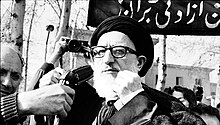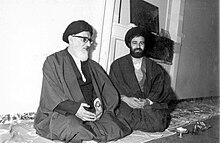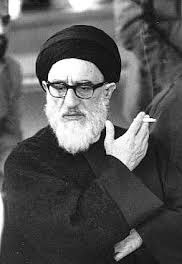| Mahmoud Taleghani | |
|---|---|
 | |
| Member of the Assembly of Experts for Constitution | |
| In office 15 August 1979 – 9 September 1979 | |
| Constituency | Tehran Province |
| Majority | 2,016,801 (79.3%) |
| Tehran's Friday Prayer Imam | |
| In office 27 July 1979 – 9 September 1979 | |
| Appointed by | Ruhollah Khomeini |
| Preceded by | Hassan Emami |
| Succeeded by | Hussein-Ali Montazeri |
| Head of Council of the Islamic Revolution | |
| In office 1 May 1979 – 9 September 1979 | |
| Preceded by | Morteza Motahari |
| Succeeded by | Mohammad Beheshti |
| Personal details | |
| Born | Seyyed Mahmoud Alaei Taleghani (1911-03-05)5 March 1911 Galird, Sublime State of Persia |
| Died | 9 September 1979(1979-09-09) (aged 68) Tehran, Interim Government of Iran |
| Resting place | Behesht-e-Zahra |
| Nationality | Iranian |
| Political party |
|
| Theological work | |
| Religion | Islam |
| Denomination | Twelver Shīʿā |
| School | Jaʿfari |
| Main interests | Tafsir |
| Years active | 1921–1979 |
| Alma mater | Najaf Seminary Feyziyeh Seminary |
| Taught at | Sepahsalar School |
| Influenced | |
| Influenced by | |
Sayyid Mahmoud Alaei Taleghani (Persian: سید محمود طالقانی, pronunciation, also romanized as Mahmūd Tāleqānī; 5 March 1911 – 9 September 1979) was an Iranian theologian, Muslim reformer, democracy advocate, a senior Shia Islamic scholar and thinker of Iran, and a leader in his own right of the movement against Shah Mohammad Reza Pahlavi. A founding member of the Freedom Movement of Iran, he has been described as a representative of the tendency of many "Shia clerics to blend Shia with Marxist ideals in order to compete with leftist movements for youthful supporters" during the 1960s and 1970s. His "greatest influence" has been said to have been in "his teaching of Quranic exegesis," as many later revolutionaries were his students.
He was Tehran's first Friday Prayer Imam after the Iranian Revolution.
Biography and education
Taleghani was born to a religious family in the village of Galird of Taleqan County in Alborz Province on 5 March 1911. His father Abu'l-Hasan Taleghani, who had published a magazine called Balagh in the context of the Kashf-e hijab protests at the time of Reza Shah, taught him Islamic sciences. Taleghani continued his studies in Qom, studying the same subject at the Razaviya and Feyziyeh schools. He obtained his Ijtihad Certification from his teachers, Abu l-Hasan al-Isfahani and Abdul-Karim Ha'eri Yazdi, there.
Political activities
Before the Iranian Revolution
In 1938, he went to Tehran to preach and lecture on Islam and was arrested and imprisoned the next year for opposing the regime of Reza Shah. From 1948 onward, he held classes at Hedayat Mosque in Tehran. Ayatollah Taleghani had the responsibility of educating revolutionary folks from the very beginning. He traveled abroad to Jordan and Egypt in 1951 and 1952, to the Peoples Muslim Congress in Karachi, and twice to Jerusalem as the head of an Iranian delegation to the annual Islamic Congress of Quds. He supported Mohammed Mosaddeq's nationalization of the oil industry. Following the 1953 Iranian coup d'état that overthrew Mossaedegh and restored the Shah he was arrested and – according to the Islamic Republic's IRIB website – "accused of hiding Navvab Safavi, the founder and leader of the Fadayan-e Islam" Islamist assassination group.
Politically active from his student days, Taleghani was a veteran in the struggle against the Pahlavi regime. He was imprisoned on several occasions over the decades, "as a young preacher, as a mid-ranking cleric, and as a senior religious leader just before the revolution," and served a total of a dozen years in prison. In his time in prison he met many leftist political prisoners and "was particularly fond of talking about his interactions with leftists." The influence of the left on his thinking was reflected in his famous book Islam and Ownership (Islam va Malekiyat) which argued in support of collective ownership "as if it were an article of faith in Islam." He helped found the National Resistance Movement in 1957 and along with Mehdi Bazargan, Yadollah Sahabi, and Ali Shariati he founded the Iran Freedom Movement in May 1961. In 1971 he exiled to Zabol, a city in Sistan and Baluchestan Province and then to Baft a city of Kerman Province. Between 1964 and 1978 he spent nearly a decade in jail. Altogether he spent nearly 15 years behind bars. Finally, Taleghani after the rise of the Islamic Revolution in November 1978 was released.
In the Iranian Revolution
Although not as influential as Ayatollah Ruhollah Khomeini, Taleghani was instrumental in "shaping the groundswell movement" that led to the Iranian Revolution and brought Khomeini to power. During the Islamic Revolution he became chairman of the "secretive" Revolutionary Council, Iran's chief ruling body – a fact not revealed until his death. In order of Ayatollah Khomeini, he was the first Imam for Friday prayer in Tehran after the fall of Iran's interim government, In the late July 1979.
Taleghani was "known for his tolerance" and "served as Khomeini's mediator in disputes with the Kurds and other dissident groups." He also had differences with Khomeini, which led to a clash between them in April 1979. "To popular acclaim, Taleghani warned then against a 'return to despotism.'" Two of Taleghani's sons were arrested by revolutionary Guards, but thousands of his supporters marched in the streets chanting "Taleghani, you are the soul of the revolution! Down with the reactionaries!'ì" Khomeini summoned Taleghani to Qom where he was given a severe criticism after which the press was called and told by Khomeini: "Mr. Taleghani is with us and he is sorry for what happened." Khomeini pointedly did not refer to him as Ayatollah Taleghani.
Opinions
| This section needs additional citations for verification. Please help improve this article by adding citations to reliable sources in this section. Unsourced material may be challenged and removed. (July 2017) (Learn how and when to remove this message) |

Taleghani argued that colonization was a primary reason of totalitarianism and dictatorship in different countries. While not an ultimate aim per se, nationalism was seen as an instrument of anti-colonialist practices. Taleghani emphasized the resistance against Israel, and travelled many times to Palestine.
On 20 April 1979, it was broadcast on television interview by Taleghani that "The leadership of Ayatollah Khomeini is not only accepted by me but the world has accepted it. He is the source of belief, sincerity, determination and honesty. I have always approved of his struggles, his words and his projects".
There is an important place for rationality in Taleghani's thought. According to him, every judgment in Islam has a reason. Also, Islam is seen in his sermons and writings as a religion that set up progressive rules in societal and individual life.
According to Taleghani, the redaction of Quran occurred under the caliphate of the first Caliph Ali. Taleghani also emphasized the continuous form of the Quran, and the strict relation between the verses of the Quran.
His tafsir, or Quranic commentary, was innovative in language and clearly designed to appeal to a wide audience, with the use of narrations and juridical reports. Taleghani insisted that believers have to contemplate the meaning of the verses of the Quran. He also sought to translate and explain the Nahj al-Balagha against the grain of contemporary social analyses and phenomena.
Death

Taleghani died on 9 September 1979. Two sons of Taleghani claimed that he was murdered but this claim was not proven. His mysterious death and lifetime achievements were the occasion of huge crowds and much emotion before and during his funeral, and was said to be "a blow to moderation and progressive thought" in the revolution.
He has been described as a "chain smoker" and having a "gaunt face with a serious demeanor."
Ayatollah Ruhollah Khomeini described him "Abu Dhar al-Ghifari in the time" in the message on the occasion of his death: "He was for Islam, Abuzar of the time. His expressive tongue was as trenchant and pounding as the sword of Malik al-Ashtar."
Works
- A shining ray from Quran, it was written while he was imprisoned by the Muhammad Reza Pahlavi.
- Introduction - explanation on Tanbih Al-Omah va Tanzih Al-Mellah
- Islam and Ownership
- Translation of the first volume of Imam Ali Ibn Abi Talib's Book
- A light of Nahj-ul-Balaq
- Authority and Judicial Decree
- Freedom and Despotism
- Unity Lesson
- A Lesson from Quran
- Days and Lectures
- Sermons of Friday Prayers
References
- Gerhard Böwering, Patricia Crone, Mahan Mirza (2013), The Princeton Encyclopedia of Islamic Political Thought, Princeton University Press, p. 505, ISBN 9780691134840
{{citation}}: CS1 maint: multiple names: authors list (link) - Vakil, Sanam (2011), Women and Politics in the Islamic Republic of Iran: Action and Reaction, A&C Black, p. 85, ISBN 9781441197344
- R. Michael Feener (2004), Islam in World Cultures: Comparative Perspectives, ABC-CLIO, p. 89, ISBN 9781576075166
- Hussein Abdul-Raof (2012), Theological Approaches to Qur'anic Exegesis: A Practical Comparative-contrastive Analysis, Routledge, p. 3, ISBN 9780415449588
- Nasr, Vali, The Shia Revival, Norton, (2006), pp. 126–7
- ^ Bakhash, Shaul, Reign of the Ayatollahs (1984), p. 168
- "گزارش: اولین نماز جمعه تهران چگونه و توسط چه کسی اقامه شد؟ + عکس". tasnimnews.
- ^ Sahimi, Mohammad (30 October 2009). "The power behind the scene: Khoeiniha". PBS. Retrieved 3 August 2013.
- Mahmoud Taleghani. Society and Economics in Islam. Mizan Press. p. 10.
- Contemporary Islamic Economic Thought: A Selected Comparative Analysis. Alhoda UK. 1995. p. 93. ISBN 9789839960440.
- Afrasiabi, Bahram. Taleghani and history. Tehran: Niloofar. p. 31.
- the Karizma of Hedayt Mosque, Mohsen Saeedi, Zamaneh Magazine, Tir 1383 solar, in Persian, number 22
- ^ Ayatollah Mahmood Taleqani Islamic Republic of Iran Broadcasting (official government biography of Taleghani)
- ^ Nasr, Vali, The Shia Revival, Norton, (2006), p. 127
- ^ "Milestones, Sep. 24, 1979". Time. 24 September 1979. Archived from the original on 16 October 2007.
- M. Stephan (7 December 2009). Civilian Jihad: Nonviolent Struggle, Democratization, and Governance in the Middle East. Springer. p. 188. ISBN 9780230101753.
- Hamad Subani (2013). The secret history of Iran. Lulu.com. p. 268. ISBN 9781304082893.
- Ali Rahnema (3 June 2000). An Islamic Utopian: A Political Biography of Ali Shariati. I.B.Tauris. p. 98. ISBN 9781860645525.
- ^ "Demise of Ayatollah Taleghani". Islamic Revolution Document Center. Archived from the original on 13 April 2013. Retrieved 21 June 2016.
- ^ Kifner, John (20 April 1979). "Ayatollah Taleghani Backs Away From a Showdown With Khomeini". The New York Times.
- Mackay, Iranians, (1998), p. 291
- the ideas of Anti colonization of the late taleghani, Hosein Khamsehei, 1389 solar, number 56, contemporary history of Iran
- "پیشبینی آیتالله طالقانی درباره آزادی قدس". iribnews.
- "نشریه حوزه – دفتر تبلیغات اسلامی حوزه علمیه قم – کتابخانه مدرسه فقاهت".
- inquiry on the Gathering and consistency of verses from orientalists and Ayatollah Taleghani, Abolfazl khoshmanesh, Pajoheshnameh olum Quran karim, in Persian, number 8, fall 1389 solar
- the commentary of Ayatollah Taleghani, an sophisticated and topical one, the magazine of Quranic sciences and Hadith, fall and winter 1387 solar, number 3, p.55-94
- خوشمنش,ابوالفضل (4 January 1391). "التفات به نهج البلاغه در آثار برخی از رهبران نهضت های بیداری جهان اسلام معاصر". 1 (10).
{{cite journal}}: Cite journal requires|journal=(help) - Mark Bowden (December 2007). Guests of the Ayatollah: The Iran Hostage Crisis: The First Battle in America's War with Militant Islam. Grove/Atlantic. p. 26. ISBN 9781555846084.
- Keddie, Modern Iran, (2006), p. 245
- Nasr, Vali, The Shia Revival, Norton, (2006), p. 126
External links
- [REDACTED] Media related to Mahmoud Taleghani at Wikimedia Commons
| Political offices | ||
|---|---|---|
| Preceded byMorteza Motahari | President of Council of Islamic Revolution 1979 |
Succeeded byAbolhassan Banisadr |
| Religious titles | ||
| Preceded byHassan Emami | Friday prayers Imam of Tehran 1979 |
Succeeded byHussein-Ali Montazeri |
- 1911 births
- 1979 deaths
- Iranian ayatollahs
- Muslim reformers
- Iranian reformists
- Iranian democracy activists
- 20th-century Muslim theologians
- Freedom Movement of Iran politicians
- People of the Iranian revolution
- Iranian revolutionaries
- National Front (Iran) politicians
- Council of the Islamic Revolution members
- Members of the Assembly of Experts for Constitution